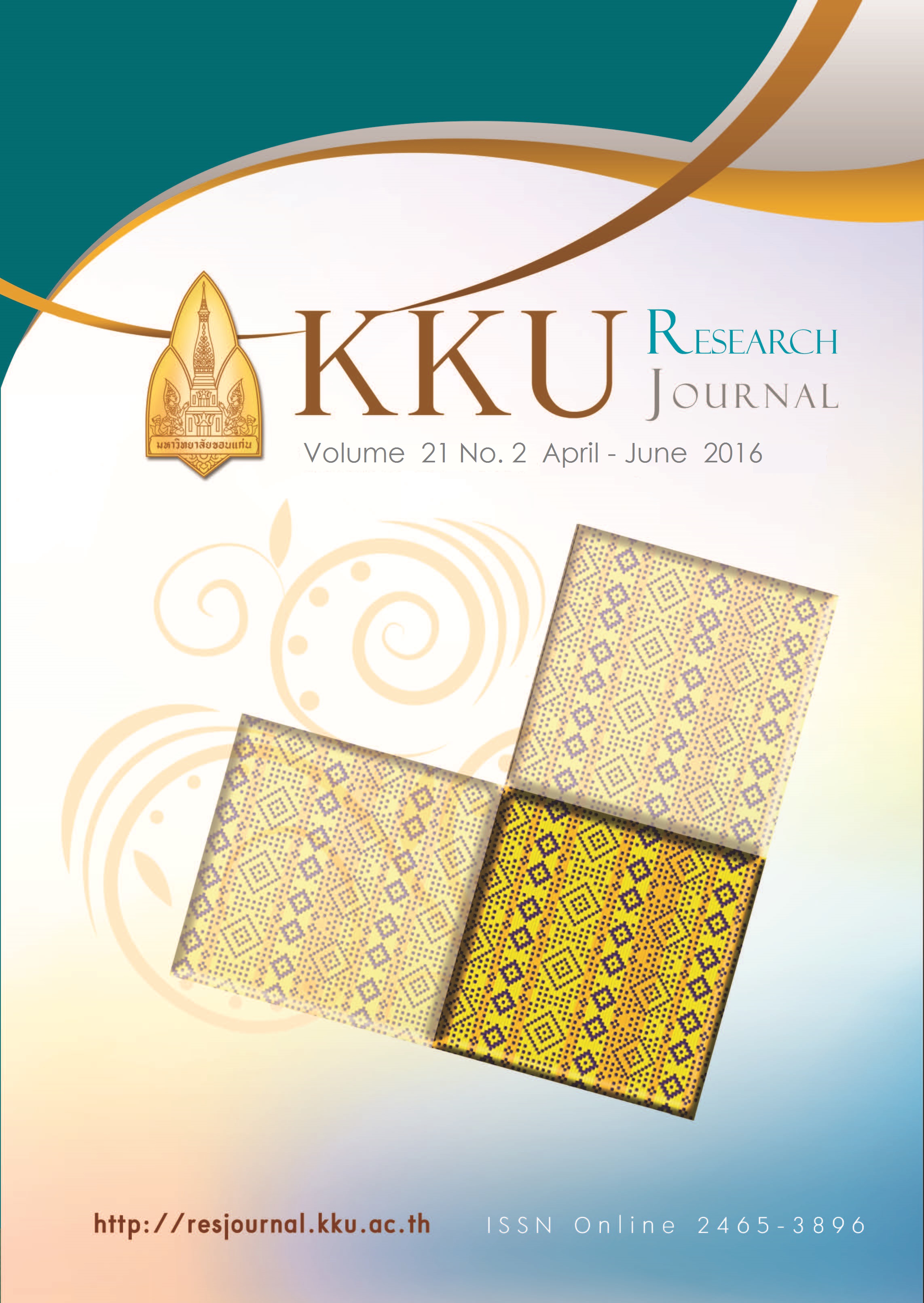Effect of impregnation solution ratio and periods on vacuum impregnated papaya
Main Article Content
Abstract
Papaya is a popular tropical fruit that is widely consumed in Thailand. In this study, fresh papaya fruit was subjected to vacuum impregnation to have a better understanding about the process parameters, including impregnation solution ratio, impregnation time and relaxation time. The fresh fruit was cut into pieces, added to impregnation solutions at ratios of 1:5 or 1:10, vacuum impregnated at 50 mbar for 5 or 10 min and left for another 10 or 30 min in the impregnation solution. After separating the fruit from the solution, it was analyzed for the fruit physicochemical properties, including real porosity (εr), volume of fruit impregnated with an external solution (X value), fruit volume deformation (γ value), effective porosity (εe), water loss and solid gain. Different factors
investigated in this study significantly affected vacuum impregnated parameters of papaya pieces (p<0.05). The papaya treatment in the impregnation solution at 1:10 with 10 min vacuum time and 30 min relaxation time significantly produced the highest solid gain (3.36±0.37%), X value (0.24±0.01 m3 liquid/m3 sample), γ value (0.14±0.03 m3/m3 initial sample) and εe value (0.11±0.05%). At the same time, this particular papaya sample possessed the lowest water loss (–15.22±3.65%) and εr value (0.16±0.01%). Data in this study strongly indicated higher impregnation solution ratio with longer impregnation and relaxation periods produced better infusion of impregnation solution in papaya pieces.
Article Details
References
[2] Derossi A, Pilli TD, Severini C. The application of vacuum impregnation techniques in food industry. In: Valdez B, editor. Scientific, health and social aspects of the food industry. Croatia: InTech; 2012. Available from: https://www.intechopen.com/books/ scientific-health-and-social- aspects-ofthe-food-industry/the- application-of-vacuum-impregnation-techniques-in-food-industry.
[3] Dotto GL, Vieira MLG, Pinto LAA. Use of chitosan solutions for the microbiological shelf life extension of papaya fruits during storage at room temperature. Food Sci Technol. 2015 Nov;64(1):126-130.
[4] Fernandes FAN, Rodrigues S, Gaspareto OCP, Oliveira EL. Optimization of osmotic dehydration of papaya followed by air-drying. Food Res Int. 2006 May;39(4):492-498.
[5] Fito P, Chiralt A, Barat JM, Andrés A, Martínez-Monzó J, Martínez- Navarrete N. Vacuum impregnation for development of new dehydrated products. J Food Eng. 2001 Sept;49(4):297-302.
[6] Fuggate P, Wongs-Aree C, Noichinda S, Kanlayanarat S. Quality and volatile attributes of attached and detached ‘Pluk Mai Lie’ papaya during fruit ripening. Sci Hortic-Amsterdam. 2010 Sept 13;126(2):120-129.
[7] Gras ML. Vidal D, Betoret N, Chiralt A, Fito P. Calcium fortification of vegetables by vacuum impregnation interactions with cellular matrix. J Food Eng. 2003 Feb;56(2-3):279-284.
[8] Ikram EHK, Stanley R, Netzel M, Fanning K. Phytochemicals of papaya and its traditional health and culinary uses. J Food Compost Anal. 2015 Aug;41:201-211.
[9] Krasaekoopt W, Suthanwong B. Vacuum impregnation of probiotics in fruit pieces and their survival during refrigerated storage. Kasetsart J (Natural Science). 2008 Jun 23;42(4):723-31.
[10] Mújica-Paz H, Valdez-Fragoso A, López-Malo A, Palou E, Welti-Chanes J. Impregnation properties of some fruits at vacuum pressure. J Food Eng. 2003a March;56(4):307-314.
[11] Mújica-Paz H, Valdez-Fragoso A, López-Malo A, Palou E, Welti-Chanes J. Impregnation and osmotic dehydration of some fruits: effect of the vacuum pressure and syrup concentration. J Food Eng. 2003b May;57(4):305-314.
[12] Paes SS, Stringari GB, Laurindo JB. Effect of vacuum and relaxation periods and solution concentration on the osmotic dehydration of apples. Int J Food Sci Tech. 2007; 42: 441-447.
[13] Panarese V, Dejmek P, Rocculi P, Galindo FG. Microscopic studies providing insight into the mechanisms of mass transfer in vacuum impregnation. Innov Food Sci Emerg Technol. 2013 April;18:169-176.
[14] Rongkom H, Phianmongkhol A, Wirjantoro TI. Physical properties of impregnated cantaloupe and apple affected by different pressure levels. Asian J Agric Food Sci. 2013;1:163-171.
[15] Subhadrabandhu S, Nontaswatsri C. Combining ability analysis of some characters of introduced and local papaya cultivars. Sci Hortic-Amsterdam. 1997 Dec;71 (3-4):203-212.
[16] Udomkun P, Nagle M, Mahayothee B, Müller J. Laser-based imaging system for non-invasive monitoring of quality changes of papaya during drying. Food Control. 2014 Aug;42:225-233
[17] Ursachi C, Segal R, Muresan C. Vacuum impregnation viability of some fruits. J Agroaliment Proc Technol. 2009;15(2):316-319.
[18] Waghmare RB, Annapure US, Combined effect of chemical treatment and/or modified
atmosphere packaging (MAP) on quality of fresh-cut papaya. Postharvest Biol Tec. 2013 Nov;85:147-153.
[19] Yan Z, Sousa-Gallagher MJ, Oliveira FAR, Shrinkage and porosity of banana, pineapple, and mango slices during air-drying. J Food Eng. 2008: 84: 430-440.
[20] Zhao Y, Xie J. Practical applications of vacuum impregnation in fruit and vegetable processing. Trends Food Sci Tech. 2004 Sept;15(9):434-451.


